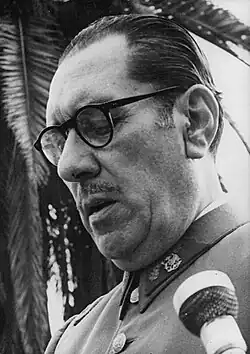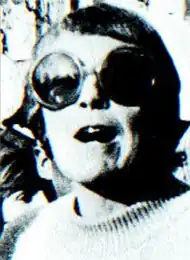Alejandrina Cox incident

The Alejandrina Cox incident (Spanish: Incidente Alejandrina Cox) was a political scandal in Chile that took place on 27 June 1973, involving General Carlos Prats, then Minister of the Interior and commander-in-chief of the Chilean Army. During a traffic altercation in Santiago, Prats fired his weapon at a civilian vehicle, mistakenly believing the driver—Alejandrina Cox, a woman with short hair—to be a man mocking him. The incident caused public outrage and media frenzy, leading to a severe blow to Prats' credibility and authority within the military. Though he briefly regained prestige by quelling a failed coup two days later, the scandal ultimately forced his resignation in August 1973. He was replaced by General Augusto Pinochet, removing the last institutional barrier to the military coup that overthrew President Salvador Allende on 11 September 1973.
Background
In 1973, Chile experienced a surge of civil unrest that reflected both support and opposition for the policies of President Salvador Allende and his Popular Unity government. General Carlos Prats, who served as both Minister of the Interior and commander-in-chief of the Chilean Army, was tasked with maintaining order in a highly polarized nation. The Chilean military held mixed views on Allende, a staunch Marxist, with some factions advocating for his removal and others arguing for his tolerance. Prats, a prominent proponent of the Schneider Doctrine, represented the Chilean military's constitutionalist stance against military intervention in Allende's leftist government.
According to later revelations, right-wing groups including Patria y Libertad and CIA operatives had been planning to discredit Prats as part of a broader strategy to remove obstacles to a military coup. Documents suggest these groups conducted psychological studies of Prats' personality to exploit his potential reactions in stressful situations.[1]
Incident

On 27 June 1973, General Carlos Prats was being driven to his office in his official car through a busy intersection in Las Condes, an upper-class suburb of Santiago. At that time, due to the animosity directed towards him, he was frequently insulted by people in nearby cars. As he drove through the intersection, a small red Renault car pulled up next to him, and its occupant began mocking and making obscene gestures towards him.
Contemporary accounts differ on the exact sequence of events. According to most reports, Prats asked his driver to hand him his handgun and, pointing it at the red car, ordered the driver to stop. When the other driver ignored him, the general shot at the red car's left front fender. Both cars immediately stopped, and the drivers emerged. It was then that the general discovered that the other driver was Alejandrina Cox (sometimes referred to as Virginia Cox in some accounts), an upper-class housewife whose short hair had led him to mistake her for a man.[2]
Alternative accounts suggest the incident may have been a deliberate provocation. According to investigations by journalist Robinson Rojas, Cox's vehicle was part of a coordinated operation involving multiple cars that had been harassing Prats' vehicle for approximately 25 blocks before the confrontation.[3] These accounts claim that operatives from Patria y Libertad and possibly CIA assets had planned the incident to provoke Prats into a public outburst that would damage his reputation.[1]
As General Prats confronted Mrs. Cox, a crowd began to gather, and many sided with the woman. The general's official car was blocked from moving, and he was soon being insulted. A passing taxi driver rescued him from the street after his car was vandalized and his tires were slashed.[2]
Immediate aftermath
General Prats immediately went to the Palacio de La Moneda, where he tendered his resignation to President Allende. However, the president refused to accept it and convinced him to stay in the government. Reports of the incident quickly made headlines on the front pages of the newspapers. Allende's opposition seized on the event, accusing the general of cowardice and of losing his self-control by firing at the vehicle of an unarmed woman. However, the government press defended him, stating that General Prats had been provoked and that the incident could have been a failed attempt on his life.[4] The incident occurred within a block of where General René Schneider had been assassinated three years prior.
The Chilean Army general staff publicly backed General Prats, but the controversy surrounding the issue, combined with existing social unrest, continued to simmer. Two days after the incident, Prats would regain some standing through his handling of the Tanquetazo coup attempt on 29 June. He personally confronted rebel tanks and negotiated their surrender, demonstrating courage under fire.[5] However, this temporary recovery of prestige would not overcome the damage done by the Cox incident.
Political consequences
The incident severely damaged Prats' reputation as a serious and level-headed defender of the Schneider Doctrine, which sought to keep the military out of civilian affairs. As commander-in-chief of the Chilean Army, Prats' standing was weakened in the eyes of the officer corps, and he remained in office for less than two months after the incident. Eventually, Prats and Cox apologized to each other. Although Prats recovered some of his public standing by his bravery during the Tanquetazo, his position was permanently undermined.[6]
On 22 August 1973, public protests led by the wives of his generals and officers in front of his home further eroded Prats' support. These protests were reportedly organized by right-wing women's groups with possible CIA involvement, using tactics developed by Brazilian operative Glaycon de Paiva who specialized in "mobilizing female power" for political purposes.[1] This ultimately led to his resignation as commander-in-chief of the Army. His resignation removed the last obstacle for those seeking to overthrow Allende by force. It also coincided with the approval of a resolution by the Chamber of Deputies that alleged the government was not respecting the constitution. The following day, Allende appointed Augusto Pinochet to replace Prats as commander-in-chief of the Army. Three weeks later, on 11 September 1973, the Chilean coup occurred, and the military overthrew Allende.
Later analysis
Historians have debated whether the incident was spontaneous or orchestrated. Margaret Power's research suggests the event was exploited by right-wing forces regardless of its origins: "The right-wing parties used the incident as a pretext for demanding that Prats resign, thus removing the last significant impediment to the then-hatching coup."[7]
The incident's location near Schneider's assassination site added symbolic weight. As noted in La Segunda's retrospective: "The state of Prats' psyche was understandably deteriorated to the extreme... he couldn't help but remember the traffic jam provoked to facilitate the crime against his predecessor René Schneider in the same route."[8]
See also
References
- ^ a b c Vega Contreras, Luis. "La caída de Allende. Parte II" (PDF). Rebelión.
- ^ a b "El ocaso de Prats en el gobierno". Special edition (in Spanish). La Segunda. 5 September 2003. p. 9.
- ^ Rojas, Róbinson. "Estos mataron a Allende" (PDF). Róbinson Rojas Databank.
- ^ "Trouble, Terror and Takeover". Time. 9 July 1973.
- ^ "La sangre de los generales" (in Spanish). La Tercera.
- ^ "Se desata la crisis" (in Spanish). Archived from the original on 2 August 2007. Retrieved 22 September 2006.
- ^ Power, Margaret. "Right-Wing Women in Chile: Feminine Power and the Struggle Against Allende, 1964-1973". Latin American Politics and Society.
- ^ "Allende" (PDF) (in Spanish). La Segunda.
External links
- "El ocaso de Prats en el gobierno" (PDF). La Segunda (in Spanish). 5 September 2003. p. 9. Archived from the original (PDF) on 12 October 2016. (archived)
- Stuven, Ana María (August 2003). "Margaret Power, Right-Wing Women in Chile: Feminine Power and the Struggle Against Allende, 1964-1973". Historia. 36. Santiago: 477–480. doi:10.4067/S0717-71942003003600025.
- "Alejandrina Cox Palma". Geni.com. (Biographical information)